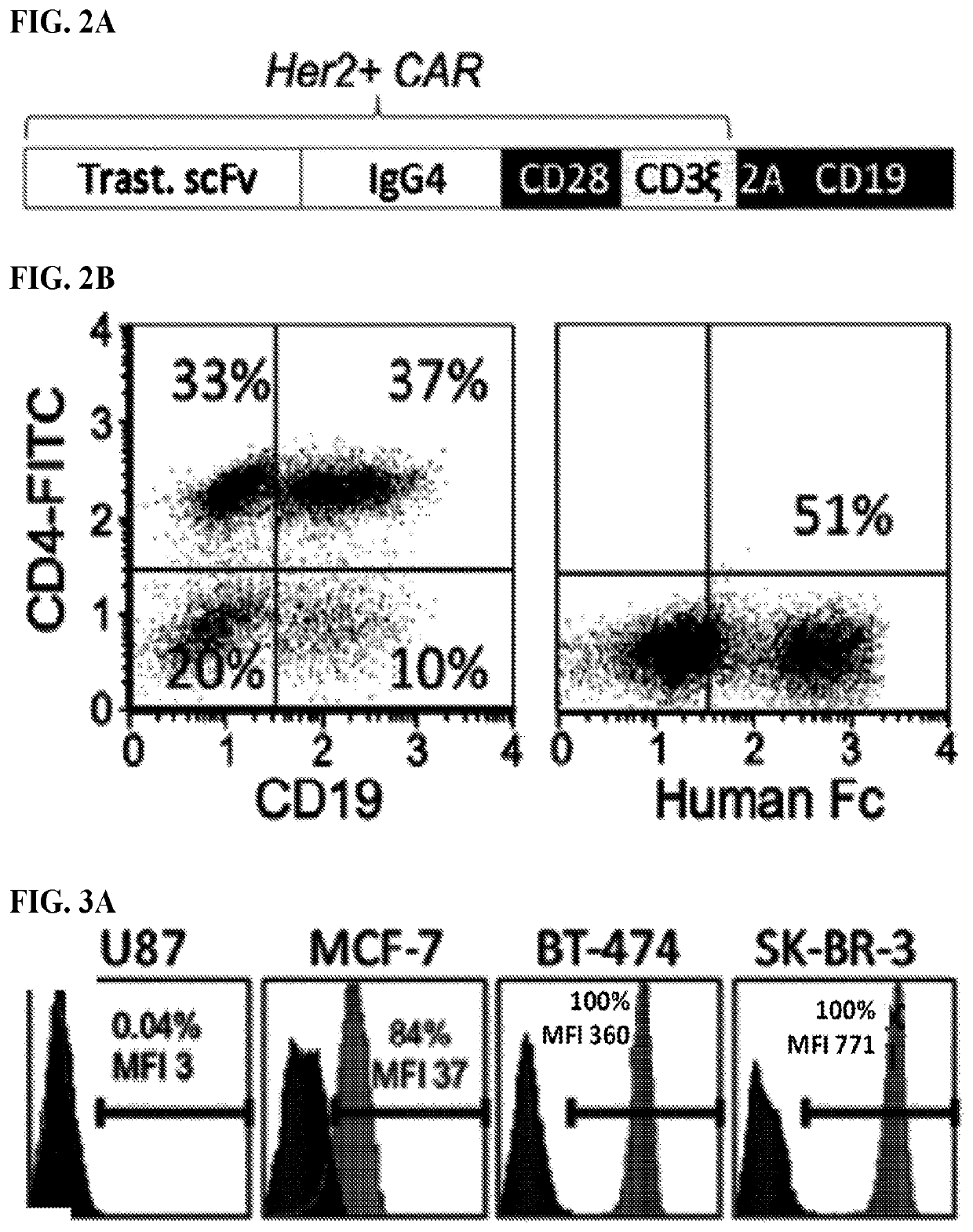Use of endogenous viral vaccine in chimeric antigen receptor T cell therapy
a technology of chimeric antigen receptor and endogenous viral vaccine, which is applied in the direction of dsdna viruses, antibody medical ingredients, peptide sources, etc., can solve the problems of disease recurrence, significant risk of transplant-related complications, and allogeneic hct associated with both significant risks of transplant-related complications
- Summary
- Abstract
- Description
- Claims
- Application Information
AI Technical Summary
Benefits of technology
Problems solved by technology
Method used
Image
Examples
example 1
[0375]Enrichment of CMV-specific T cells from PBMC of healthy donors after stimulation with cGMP grade CMVpp65 protein
[0376]CMV-specific T cells were prepared from PBMC of healthy donors by stimulating the PBMC with cGMP grade CMVpp65 protein. Briefly, PBMCs were isolated by density gradient centrifugation over Ficoll-Paque (Pharmacia Biotech, Piscataway, N.J.) from peripheral blood of consented healthy, HLA-A2 CMV-immune donors under a City of Hope Internal Review Board-approved protocol. PBMC were frozen for later use. After overnight rest in RPMI medium containing 5% Human AB serum (Gemini Bio Products) without cytokine, the PBMC were stimulated with current good manufacturing practice (cGMP) grade CMVpp65 protein (Miltenyi Biotec, Germany) at 10 ul / 10×106 cells for 16 hours in RPMI 1640 (Irvine Scientific, Santa Ana, Calif.) supplemented with 2 mM L-glutamine (Irvine Scientific), 25 mM N-2-hydroxyethylpiperazine-N-2-ethanesulfonic acid (HEPES, Irvine Scientific), 100 U / mL penici...
example 2
[0378]Genetic modification of enriched CMV-specific T cells to express CD19 CAR and in vitro expansion of the CMV / CAR T cells.
[0379]In the clinically adaptable procedure, IFNγ-captured CMV-specific T cells were transduced 2 days after the selection, without OKT3 activation, using the second generation CD19RCD28EGFRt lentiviral construct containing the IgG4 Fc hinge region mutations (L235E; N297Q) that improve potency due to distortion of the FcR binding domain. Starting seven days post lenti-transduction, the cells were stimulated on a weekly basis with 8000 cGy-irradiated, CD19-expressing NIH3T3 cells at a 1:10 ratio (T cells: CD19NIH3T3). The percentage of CAR+ cells detected by cetuximab increased from 8% post transduction to 46% after 2 rounds of stimulation with a 120-150-fold total cell increase (FIG. 14B and FIG. 14D). Further details regarding the lentiviral construct, the CD19-expressing NIH3T3 cells and other materials and techniques used in the studies described herein ar...
example 3
[0380]CMV / CAR T cells exhibited specific effector function after stimulation through pre-defined viral TCR and CD19CAR.
[0381]Recapitulating our previous studies (23), the ex vivo expanded CMV-specific T cells possessed an effector phenotype and no longer expressed the central memory markers of the originally selected cells, such as CD62L, CD28, and IL-7Ra (FIG. 15A and FIG. 15D). However, levels of CD27 remained high, suggesting a greater proliferative potential that has been associated with greater clinical efficacy (24). To investigate CMV / CAR T cell effector function via signaling by both the endogenous CMV-specific TCR and the introduced CD19CAR, we evaluated response to engineered pp65-expressing U251T cells from HLA-A2 donors, and also allogeneic CD19LCLs, based on cytotoxicity, cytokine production and proliferation profiles. As expected, the expanded CMV / CAR T cells specifically lysed CD19+LCLs with the same maximum killing levels as the OKT3-expressing LCL used as positive c...
PUM
 Login to View More
Login to View More Abstract
Description
Claims
Application Information
 Login to View More
Login to View More - R&D
- Intellectual Property
- Life Sciences
- Materials
- Tech Scout
- Unparalleled Data Quality
- Higher Quality Content
- 60% Fewer Hallucinations
Browse by: Latest US Patents, China's latest patents, Technical Efficacy Thesaurus, Application Domain, Technology Topic, Popular Technical Reports.
© 2025 PatSnap. All rights reserved.Legal|Privacy policy|Modern Slavery Act Transparency Statement|Sitemap|About US| Contact US: help@patsnap.com



